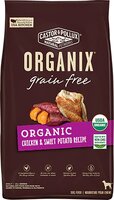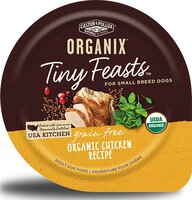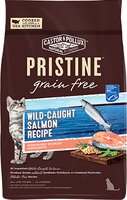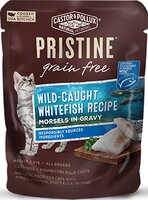
Fussie Cat vs. Castor & Pollux
In this comparison article for Fussie Cat vs Castor & Pollux, we'll highlight the key differences between these two pet food brands. To properly compare Fussie Cat and Castor & Pollux, we'll use up-to-date nutritional and price information.
There are many factors to consider when choosing the best pet food brand for your pet. Factors such as ingredient quality, guaranteed analysis, product safety, brand history, and cost are among the most important factors to consider.
Throughout this Castor & Pollux vs Fussie Cat comparison, we've utilized average data to make general comparisons. If you'd like to see individual product reviews, visit our Fussie Cat Review Page or Castor & Pollux Review Page.
Guaranteed Analysis: Castor & Pollux vs. Fussie Cat
According to AAFCO, all pet food labels must provide a guaranteed analysis of nutrient content. The analysis must provide guaranteed minimum percentages of crude protein and crude fat, and maximum percentages of crude fiber and moisture.
All percentages used in this comparison are averages reported on a dry matter basis.
Fussie Cat Cat Food vs. Castor & Pollux Cat Food
| Dry Cat Food | Fussie Cat | Castor & Pollux |
| Crude Protein | 38.4% | 38.2% |
| Crude Fat | 16.4% | 15.7% |
| Crude Fiber | 5.8% | 4.0% |
| Wet/Canned Cat Food | Fussie Cat | Castor & Pollux |
| Crude Protein | 71.8% | 43.3% |
| Crude Fat | 13.2% | 20.4% |
| Crude Fiber | 3.0% | 5.7% |
Crude Protein Comparison For Cat Food
Protein is an extremely important part of your cat's diet. Without sufficient protein, cats can develop a wide-range of serious health problems.
Castor & Pollux and Fussie Cat both provide roughly the same amount of crude protein. For wet cat foods, Fussie Cat provides significantly more protein (about 28.47% more).
Crude Fat Comparison For Cat Food
There are many ways in which dietary fat contributes to the overall health of our feline friends. Here is a short list of benefits provided by fats (not exhaustive):
- Fats help with the digestion and absorption of fat-soluble vitamins
- Reduce inflammation associated with arthritis
- Slow the growth of yeast infections
- Prevent or reduce the likelihood of certain heart problems.
- Aid in the development of the retina and visual cortex.
There is a relatively insignificant difference between the crude fat content of the two brands. For wet cat foods, Castor & Pollux provides more fat (about 7.21% more).
Both brands provide roughly the same amount of crude fiber. For wet cat foods, Castor & Pollux typically provides a little more fiber (about 2.72% more).
Fussie Cat Pet Food Ingredients vs. Castor & Pollux Pet Food Ingredients
Here are some of the controversial ingredients used only by Castor & Pollux.
We believe that certain pet food ingredients are linked to adverse health affects; these ingredients are classified as harmful.
Here are some of the harmful ingredients used only by Fussie Cat.
Here are some of the harmful ingredients used only by Castor & Pollux.
Product Safety: Recall History of Fussie Cat & Castor & Pollux?
According to our records, Fussie Cat has never been recalled.
Castor & Pollux has been recalled once.
- May 23, 2018: elevated levels of beef thyroid hormone
Price Comparison: Which Brand Is More Expensive?
| Dry Cat Food | Fussie Cat | Castor & Pollux |
| Per Pound | $4.00 | $5.50 |
| Per Calorie | $0.0025 | $0.0033 |
| Wet Cat Food | Fussie Cat | Castor & Pollux |
| Per Pound | $11.72 | $9.65 |
| Per Calorie | $0.0408 | $0.0214 |
The average cost-per-lb is heavily influenced by the varying amounts of moisture present in each brand's food products (wet vs. dry food, dry vs. freeze-dried food, etc). However, the average cost-per-kcal eliminates the influence of moisture. Therefore, the average cost-per-kcal is the better metric to consider.
If you'd like to calculate the average cost-per-day or cost-pet-year of feeding Fussie Cat or Castor & Pollux, input your pet's weight into our cost analyzer widget.
Averages price data can identify whether or not there exists a significant price difference between two brands. However, the actual price that you'll pay for Fussie Cat or Castor & Pollux will depend on your shopping habits.
Pet owners who use our price comparison feature typically save more than 25% off retail prices for Fussie Cat and Castor & Pollux. In addition, we currently have some great coupons for our readers.
- 20% Off First Auto-Ship @ PetFlow (Use Code PAWDIET20)
- 35% Off First Auto-Ship @ Chewy (No Code Required)
- 15% Off The Entire Site @ OnlyNaturalPet (Use Code AFPAWDIET)
Disclosure: PawDiet has an affiliate relationship with stores featured (or linked-to) in this article. We are compensated for referring customers. Thank you for shopping with our retail partners!
Where To Buy Fussie Cat Pet Foods
You can purchase Fussie Cat pet foods from the following stores:




Where To Buy Castor & Pollux Pet Foods
You can purchase Castor & Pollux pet food products from these retailers:



Type Of Pet Foods Available
| Product | Fussie Cat | Castor & Pollux |
| Dry Dog Food | None | 17 Recipes |
| Wet Dog Food | None | 28 Recipes |
| Dog Treats | None | 22 Treats |
| Dry Cat Food | 5 Recipes | 6 Recipes |
| Wet Cat Food | 19 Recipes | 18 Recipes |
| Cat Treats | 8 Treats | 1 Treats |
Top Rated Fussie Cat Recipes
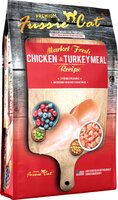
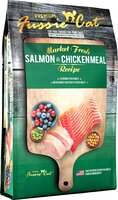
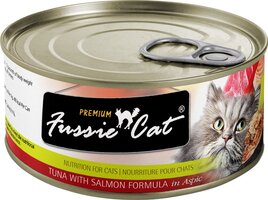
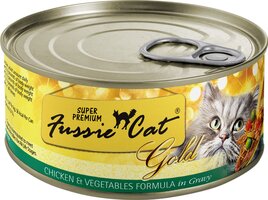
Top Rated Castor & Pollux Recipes
